
Prince of Orange is a title associated with the sovereign Principality of Orange, in what is now southern France and subsequently held by the stadtholders of, and then the heirs apparent of, the Netherlands.
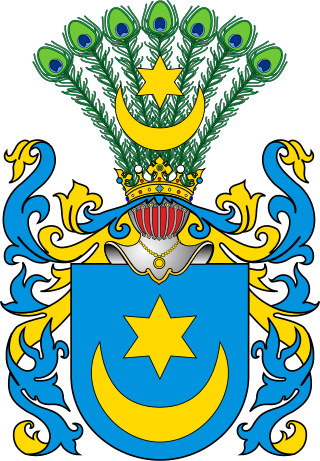
Leliwa is a Polish coat of arms. It was used by several hundred szlachta families during the existence of the Kingdom of Poland and the Polish–Lithuanian Commonwealth, and remains in use today by many of the descendants of these families. There are several forms of the arms, all of which bear the name, Leliwa, but which may be distinguished as variations of the same arms by the addition of a Roman numeral. In 19th century during a pan South-Slavic Illyrian movement heraldic term Leliwa also entered Croatian heraldry as a name for the coat of arms considered to be the oldest known symbol; Bleu celeste, a mullet of six points Or surmounted above a crescent Argent – A golden six-pointed star over a silver crescent moon on a blue shield, but also as a name for all other coats of arms that have a crescent and a mullet.

The House of Egmond or Egmont is named after the Dutch town of Egmond, province of North Holland, and played an important role in the Netherlands during the Middle Ages and the Early modern period. The main lines Egmond-Geldern, Egmond-Gavere and Egmond-Buren-Leerdam had high noble, princely rank.
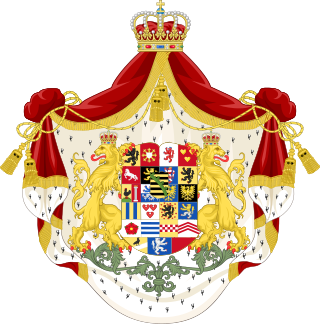
The House of Saxe-Coburg and Gotha is a European royal house. It takes its name from its oldest domain, the Ernestine duchy of Saxe-Coburg and Gotha, and its members later sat on the thrones of Belgium, Bulgaria, Portugal, and the United Kingdom and its dominions.
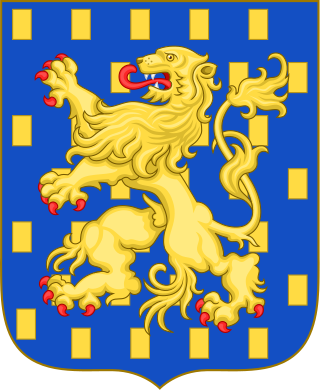
The House of Nassau is a diversified aristocratic dynasty in Europe. It is named after the lordship associated with Nassau Castle, located in present-day Nassau, Rhineland-Palatinate, Germany. With the fall of the Hohenstaufen in the first half of the 13th century royal power within Franconia evaporated and the former stem duchy fragmented into separate independent states. Nassau emerged as one of those independent states as part of the Holy Roman Empire. The lords of Nassau were originally titled "Count of Nassau", subject only to the Emperor, and then elevated to the princely class as "Princely Counts". Early on they divided into two main branches: the elder (Walramian) branch, that gave rise to the German king Adolf, and the younger (Ottonian) branch, that gave rise to the Princes of Orange and the monarchs of the Netherlands.

Geldern is a city in the federal German state of North Rhine-Westphalia. It is part of the district of Kleve, which is part of the Düsseldorf administrative region. The nearby Dutch province of Gelderland is named after this city.

The House of Limburg-Stirum, which adopted its name in the 12th century from the immediate county of Limburg an der Lenne in what is now Germany, is one of the oldest families in Europe. It is the eldest and only surviving branch of the House of Berg, which was among the most powerful dynasties in the region of the lower Rhine during the Middle Ages. Some historians link them to an even older dynasty, the Ezzonen, going back to the 9th century.

The van Amstel family was an influential dynasty in the medieval Netherlands from the twelfth until the fourteenth century. The family developed the Amstelland and held the stewardship in the ecclesiastical districts in the northwest of the Nedersticht of Utrecht, first in the name of the bishop of Utrecht and later the count of Holland.

The Gelre Armorial is a medieval armorial.

Bernhard, Count of Bylandt was a German nobleman, artist, sculptor, writer and member of the House of Bylandt or more specifically the branch of Bylandt-Rheydt. He studied art under Professor Eduard Kämpffer at the Academy of Art in Breslau. In 1939 he married the German actress Dorothea Gmelin. After divorce he remarried pianist Ilse Josten. In 1958, he became a Professor of Art at the Kunsthochschule Kassel. Bernhard's father, Count Alexander Friedrich von Bylandt-Rheydt (1863–1942) was the last owner of the family seat of Schloss Rheydt. The palace was sold to the town of Rheydt and remains a museum to this day.
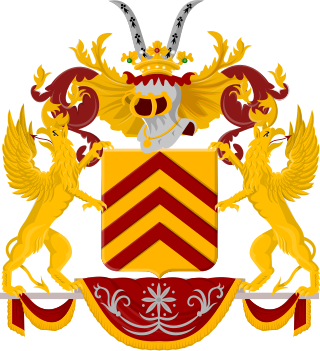
The van Voorst tot Voorst family is an old Dutch noble family from the province of Overijssel.

The House of Rechteren is the name of an old noble family belonging to the Dutch and German nobility. The German branch of Counts von Rechteren-Limpurg-Speckfeld has been mediatised.

The House of Lynden is one of the oldest families of the Dutch nobility, originating in the Duchy of Guelders. This family later gave rise to different branches. Most remained in the Netherlands and produced several Dutch politicians, ministers, and military leaders.

The Van Renesse family is an old Dutch noble family and cadet branch of the Van Voorne Family that stems from the town of Renesse in Zeeland.

Van Boetzelaer is an old aristocratic family that stems from the region of Kalkar, Germany.

The Lords of Brederode were a noble family from Holland who played an important role during the Middle Ages and the Early modern period. The family had a high noble rank and hold the titles Count of Brederode, Count of Gennep, and furthermore they ruled the souverain Lordship of Vianen, the Viscountship of Utrecht among other feudal titles.
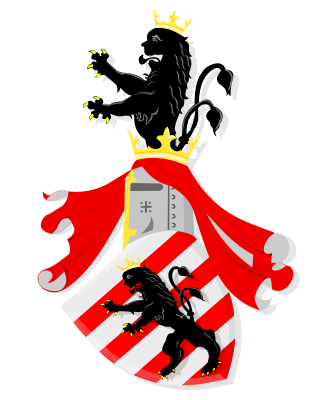
The House of Hoensbroeck is the name of an old aristocratic family with medieval origins in the town of Hoensbroek near Heerlen in Limburg, Netherlands. The family is part of Dutch and German nobility.

Van Foreest is the name of an aristocratic family that most probably originates from the region of Aachen, Germany, but is already found in the County of Holland in the 13th century. The family was already noble from earliest times ("Uradel"). In the early modern period, the family played a role in the city councils of Haarlem, Delft and Alkmaar. Members of the family are jonkheer.
Herman van Horne was Bishop of Utrecht from 1150 to 1156. Herman was son of Thiery de Looz, Count of Horn, and grandson of Emmo, Count of Looz.

The Beyeren Armorial is a manuscript roll of arms of the early 15th century, containing 1096 hand-colored coats of arms, with annotations in Middle Dutch. It is held by in the National Library of the Netherlands in The Hague (KB), shelf mark 79 K 21.






















